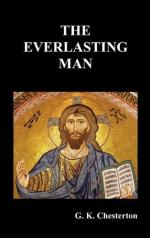
|
| Name: _________________________ | Period: ___________________ |
This test consists of 15 multiple choice questions and 5 short answer questions.
Multiple Choice Questions
1. What does Chesterton say is the main fault with comparing religions?
(a) False classification masks the uniqueness of the church.
(b) They do not resemble each other.
(c) All of these.
(d) Confucianism is not a religion.
2. What does Chesterton say of the Roman polytheism before the time of Christ?
(a) All of these.
(b) The gods took on a more domestic nature.
(c) The gods became closer to people.
(d) The gods became more localized.
3. Who or what does Chesterton credit with the preservation of the true religion of mankind?
(a) The Jews.
(b) Human nature.
(c) Natural law.
(d) God.
4. What religious activity does Chesterton align with Carthage?
(a) Infanticide.
(b) Prayers for materialistic ends.
(c) All of these.
(d) Devil worship.
5. What example does Chesterton give about how the church must be viewed?
(a) With the wonder of somebody seeing it for the first time.
(b) From the daily experiences within it.
(c) With the eyes of an anthropologist.
(d) With the detached impartiality of a martian.
6. What opinion does Chesterton hold of the concept "realpolitik," or the notion that men fight for material purposes?
(a) It is true unless the men have religion.
(b) It is a simplistic rendering of a complex problem.
(c) It is an almost insanely unreal concept.
(d) None of these.
7. What does Chesterton say is important when viewing mankind?
(a) Realizing what a strange animal he is.
(b) Seeing him through the eyes of religion.
(c) Separating him from historical explanations.
(d) Not comparing him to other animals.
8. Which one of the following is NOT, according to Chesterton, one of the great mysteries?
(a) The origin of the universe.
(b) The origin of mankind.
(c) The origin of life.
(d) The origin of God.
9. What form of humanity does Chesterton claim is the unit of the state, or the cell that makes up the formation?
(a) Motherhood.
(b) Male lineage.
(c) Family.
(d) Tribes.
10. What reason does Chesterton give for acts of cannibalism?
(a) It is practical for those without the morality to know it is an abomination.
(b) The people believe the power of life is transferable.
(c) The lack of a true creed and religion.
(d) The people are doing the worst thing they can imagine.
11. What does Chesterton take as evidence that evolution is flawed as a way to define the origins of man?
(a) None of these.
(b) The missing link.
(c) The fact that mankind is apparently not evolving now.
(d) The changing nature of the theories.
12. In what way does Chesterton say the the Christian is worse than the pagan in examples such as Mexico and Carthage?
(a) He is worse because it is his business to be better.
(b) He is worse because he inflicts his wrath on other peoples.
(c) He is worse because he is more evolved.
(d) He is worse because he is better at justifying his actions.
13. What evidence does Chesterton find in the history of Babylonia?
(a) Evidence to refute the commonly held notion of barbarism and civilization.
(b) Nomads who do not evolve into a more civilized state.
(c) All of these.
(d) A society that has no evidence of being nomadic.
14. How does Chesterton interpret the title of the book, "The Evolution of the Idea of God"?
(a) I will show you how this nonsensical notion that there is a God grew up among men.
(b) How God changes to suit the needs of every time and place.
(c) How mankind has lost their way.
(d) The growth of understanding morality.
15. Which of the following is a statement that Chesterton makes?
(a) The moment we are really impartial about it, we know why people are partial to it.
(b) The church is justified, not because her children do not sin, but because they do.
(c) The next best thing to being really inside Christendom is to be really outside it.
(d) All of these.
Short Answer Questions
1. What does Chesterton say is a danger when analyzing mythologies?
2. Which of the following is something Chesterton says future scientists will deduce from 20th Century initials carved in stone?
3. What does Chesterton attempt to prove by the universality of clothes?
4. What does Chesterton say is the real rival to the the Church of Christ?
5. Chesterton claims the holy trinity is an upside version of what?
|
This section contains 762 words (approx. 3 pages at 300 words per page) |

|




